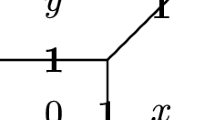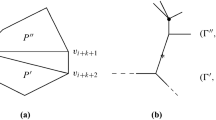Abstract
We generalize the standard combinatorial techniques of toric geometry to the study of log Calabi–Yau surfaces. The character and cocharacter lattices are replaced by certain integral linear manifolds described in Gross et al. (Math. Inst. Hautes Etudes Sci. 122, 65–168, 2015), and monomials on toric varieties are replaced with the canonical theta functions defined in Gross et al. (2015) using ideas from mirror symmetry. We describe the tropicalizations of theta functions and use them to generalize the dual pairing between the character and cocharacter lattices. We use this to describe generalizations of dual cones, Newton and polar polytopes, Minkowski sums, and finite Fourier series expansions. We hope that these techniques will generalize to higher-rank cluster varieties.


Similar content being viewed by others
Notes
Choosing a cyclic ordering for the components of D (assuming D has at least three components) is equivalent to choosing an orientation for \(N_{\mathbb {R}}\) or \(U^{{{\mathrm{trop}}}}\). It is also equivalent to fixing the sign for the holomorphic volume form \(\Omega \) on U, which we will use in Sect. 6. We assume throughout the paper that such a choice has been fixed.
We assume here that there are more than three rays in \(\Sigma \), so that \(\sigma _{i-1,i}\cup \sigma _{i,i+1}\) is not all of \(N_{\mathbb {R}}\). This assumption can always be achieved by taking toric blowups of (Y, D). Alternatively, it is easy to avoid this assumption, but the notation and exposition become more complicated. We will therefore continue to implicitly assume that there are enough rays for whatever we are trying to do, without further comment.
When working without the positivity assumption, [8] choose some strictly convex rational polyhedral cone containing \({{\mathrm{NE}}}(Y)_{\mathbb {R}}\) to be \(P_{\mathbb {R}}\) (\(\sigma _P\) in their notation).
For \(\varphi =\eta _W\circ \varphi _{{{\mathrm{NE}}}(Y)}\) as in the second example above, we can take \(\mathbb {P}_{\varphi }\) to be the trivial bundle with \(\varphi =\varphi _W\). Since we are really only interested in tropicalizations of theta functions in this paper, restricting to this situation would be sufficient, and one can in this way avoid worrying about multi-valued functions.
When we multiply d by a positive scalar c, we map \(L_v^d(t)\) to \(cL_v^d(t)\). That way the times \(t_1,\ldots ,t_k\) are unchanged.
Consider \((\overline{Y}=\mathbb {P}^2,\overline{D}=\overline{D}_1+\overline{D}_2+\overline{D}_3)\). The \(E_7\) (resp. \(E_8\)) case refers to the Looijenga interiors \(U=Y{\setminus } D\) which can be obtained by blowing up 2 non-nodal points on \(\overline{D}_1\), 3 on \(\overline{D}_2\), and 4 (resp. 5) on \(\overline{D}_3\). \(E_7\) and \(E_8\) refer to the intersection forms on the lattices \(D^{\perp }:=\{C\in {{\mathrm{Pic\,}}}(Y)|C \cdot D_i=0 \text{ for } \text{ all } i\}\) in these cases.
A previous version of this paper incorrectly claimed that \({{\mathrm{Spec\,}}}A_{\sigma } = Z_{\sigma }\) when \(\sigma ^{\vee }\) is two-dimensional, neglecting to contract the \((-1)\)-curves.
Here we must include broken lines through the origin, by which we mean limits of sequence of broken lines which are all equivalent to each other in the sense of Sect. 3.4. In other words, in addition to the usual broken lines, we allow sets of the form \(\langle \cdot ,v\rangle = 0\) for \(v\in V^{{{\mathrm{trop}}}}(\mathbb {Z})\). These are the lines \(L_q^0\) from Definition 2.8.
If some \(q_1+_i\ldots +_i q_s\) is not defined in \(U^{{{\mathrm{trop}}}}\), we simply do not include it in the set. Alternatively, we could only include \(q_1+_i \ldots +_i q_s\) in the set if there is some convex cone \(\sigma \) in the complement of \(\rho _i\) containing each \(q_k\)—addition in a convex cone is always well defined.
Recall that if we take the cyclic ordering of \(D=D_1+\cdots +D_n\) as part of our data, then we can use this to orient \(U^{{{\mathrm{trop}}}}\), and \(V^{{{\mathrm{trop}}}}\) gets the opposite orientation. This can be used to orient \(\gamma \) (by ordering \(z_i\) and \(z_{i+1}\)). Alternatively, we can take the sign of \(\Omega \) as part of our data and say that \(\gamma \) is oriented to make \(\int _{\gamma }\Omega >0\).
References
Fock, V., Goncharov, A.: Cluster \({\cal X}\)-varieties at infinity. arXiv:1104.0407 (2011)
Fock, V., Goncharov, A.: Moduli spaces of local systems and higher Teichmüuller theory. Publ. Math. IHES 103, 1–212 (2006)
Fock, V., Goncharov, A.: Cluster ensembles, quantization and the dilogarithm. Ann. Sci.Éc. Norm. Sup. (4) 42(6), 865–930 (2009)
Fulton, W.: Introduction to Toric Varieties, Volume 131 of Annals of Mathematics Studies. Princeton University Press, Princeton (1993)
Gross, M., Hacking, P., Keel, S., Kontsevich, M.: Canonical bases for cluster algebras. arXiv:1411.1394 (2014)
Gross, M., Hacking, P., Keel, S.: Birational geometry of cluster algebras. Algebr. Geom. 2(2), 137–175 (2015)
Gross, M., Hacking, P., Keel, S.: Mirror symmetry for log Calabi-Yau surfaces II. (in preparation)
Gross, M., Hacking, P., Keel, S.: Mirror symmetry for log Calabi-Yau surfaces I. Math. Inst. Hautes Etudes Sci. 122, 65–168 (2015)
Gross, M., Pandharipande, R., Siebert, B.: The tropical vertex. Duke Math. 153(2), 297–362 (2010)
Gross, M., Siebert, B.: An invitation to toric degenerations. In: Surveys in Differential Geometry, Vol XVI. Geometry of Special Holonomy and Related Topics, Volume 16 of Surveys in Differential Geometry, pp. 43–78. Int. Press, Somerville (2011)
Gross, M., Hacking, P., Keel, S.: Moduli of surfaces with an anti-canonical cycle. Compos. Math. 151(2), 265–291 (2015)
Kontsevich, M., Soibelman, Y.: Affine structures and non-Archimedean analytic spaces. In: The Unity of Mathematics, Volume 244 of Progress in Mathematics, pp. 321–385. Birkhäuser Boston, Boston (2006)
Li, J.: A degeneration formula of GW-invariants. J. Differ. Geom. 60(2), 199–293 (2002)
Mandel, T.: Classification of rank \(2\) cluster varieties. arXiv:1407.6241v2
Shen, L.: Stasheff polytopes and the coordinate ring of the cluster \({\cal X}\)-variety of type \(A_n\). Sel. Math. (N.S.) 20(3), 929–959 (2014)
Symington, M.: Four dimensions from two in symplectic topology. In: Topology and Geometry of Manifolds (Athens, GA, 2001), volume 71 of Proceedings of Symposia in Pure Mathematics, pp. 153–208. American Mathematical Society, Providence (2003)
Acknowledgments
This paper is based on part of the author’s thesis, which was written while in graduate school at the University of Texas at Austin. I would like to thank my advisor, Sean Keel, for introducing me to this topic and for all his suggestions, insights, and support and also for allowing me access to preliminary versions of his papers with Paul Hacking and Mark Gross. I also want to thank Andy Neitzke, James Pascaleff, Yuan Yao, and Yuecheng Zhu for many valuable conversations, as well as the referee for numerous helpful suggestions. The author was partially supported by the Center of Excellence Grant “Centre for Quantum Geometry of Moduli Spaces” from the Danish National Research Foundation (DNRF95).
Author information
Authors and Affiliations
Corresponding author
Rights and permissions
About this article
Cite this article
Mandel, T. Tropical theta functions and log Calabi–Yau surfaces. Sel. Math. New Ser. 22, 1289–1335 (2016). https://doi.org/10.1007/s00029-015-0221-y
Published:
Issue Date:
DOI: https://doi.org/10.1007/s00029-015-0221-y




